 |
General Information about Zermatt
Summer holiday in the car-free city with the most famous peak of the world

At the end of July 2003, we started from my ex-home place by the Lake Constance to a little round trip through Switzerland. The ferry took us to the other side of the Lake Constance, the motorway to the mountainous country behind Zurich, first to the Lake Zug and then to the Lake Lucerne. From there, it is continued to the south, up to the Furka Pass and then down the complete Rhone valley until after countless kilometres, we turned to the left and finally land in Zermatt.
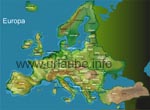
We wanted to visit Zermatt for one or two days, as it is done every year by millions of tourists; therefter, we wanted to continue to Chamonix and some other interesting places of Switzerland. But the continuation came to nothing, as at the first go, we were so enthusiastic about Zermatt, that we made a full holiday of our short stay.
What is nicer than finding a little spot on earth that one likes so much, that one makes a full holiday of a little excursion? Zermatt, its mountains, its glaciers, its grasslands, its brooks and the little city itself took a shine to us; we had a wonderful stay at the bottom of the Matterhorn that couldn't be nicer.
Our summer vacation in August 2003 in Zermatt was so beautiful, that soon, in April 2004, we added a winter holiday to it. The curiosity was high to see everything already seen in summer time in the winter time, covered by a coat of sugar. The ski holiday in the winter was as beautiful and unforgettable as the hiking holiday was in the summer time. What a beautiful place, that can provide one either in the summer as also in the winter time an unforgettable dream holiday!
Where exactly is Zermatt actually?
A view to the Swiss map shows that Zermatt is located quite at the south of Switzerland. This is why the visitors from Germany have to drive first through the whole Switzerland in order to get to their holiday place. A few kilometres further, to be exactly, "only" crossing the Theodul Pass or up to the little peak of the Matterhorn or of the Monte Rosa, and one is in Italy. Therewith, Zermatt is the most southern place where German is spoken at all.
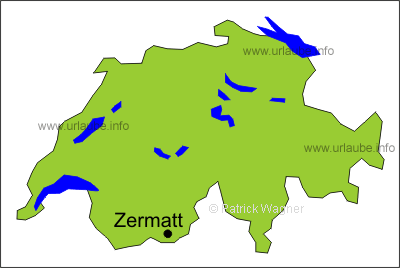
As it is easy to see in the map, there are, at the east and the west of Zermatt, even more southern places in Switzerland. But in the western places, there is already French spoken, and in the more eastern places Italian. If one drives through the Rhonetal in direction to Chamonix, the Nikolaitl is the last tributary valley where German is still spoken. The four-thousander peaks around the Weisshorn form the German~French language border in Switzerland. The mountain chain between Monte Rosa, Breithorn and Matterhorn form, to the contrary, the country border between Italy and Switzerland.
Thus, Zermatt is located at the very south, nearly in Italy. This circumstance has also an effect on the weather: in Zermatt, one already feels the Mediterranean influence. With approximately 700 mm rainfall per year, Zermatt belongs to the poorest rainfall areas of Switzerland, and there is to consider that it is a mountain village located at a height of 1600 m! All the more impressive is then that at the other side, on the Monte Rosa peak with 4100 mm, there are more rainfalls per year than in nearly every other place of the Swiss mountains. Thus, Zermatt is well protected and isolated by its four-thousanders; this is the reason why most of the times, the valley is windless.
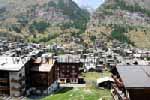
If one is on the way in Zermatt or its mountains, one is pemanently touched by the trilingualism of Switzerland (in total, there are even four Swiss national languages: German, Italian, French, Romansh language). If in a mountain shelter, one has french speaking neighbours at the table, it does not mean at all that they had a long way to here. Also in the shops of Zermatt a lot of Italian is spoken; it is possible to be attended in perfect German, but backstage, everything goes in Italian. Also in the names of the peaks, it is clearly recognizable that there are three language areas where one actually is. Peaks as the Dent Blanche or the Dent d'Hèrens were named in French, the Monta Rosa or the Cima di Jazzi were baptized by Italian speaking people.
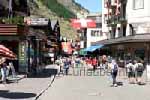
The left tributary valley of the Rhone, where Zermatt is located, is named after the former biggest place of the valley St. Niklaus Nikolai Valley. It starts at the place of entrance Visp at a height of approximately 650 m and ends in Zermatt at approximately 1600 m height. By stepping up the valley further into the south, one gets to the Theodul Glacier and finally at a height of 3300 m, located between Matterhorn and Klein Matterhorn, the Theodul Pass. At the other side of the pass, one is already in italy and gets finally to the place Breuil-Cervinia that is located at a height of 2000 m. The big valley at the south side of the mountain ridge is the Aosta Valley. In former times, the Theodul Pass served in fact as a north - south connection that was easy to access; by the way, the whole mountain ridge is a big watershed: here, the mountain water is split to both rivers Rhone at the north and Po in the south.
Why is Zermatt so famous, popular and often visited?
If in a little city of more than 5.000 inhabitants, that was a much more little village not so much time ago, each year, more than 1 million people stay over night and many more come over for a day excursion, then there must be something very outstanding and/or a complete flock of specialities must come together on this little spot. What is it that gives Zermatt its unique flair and reputation?
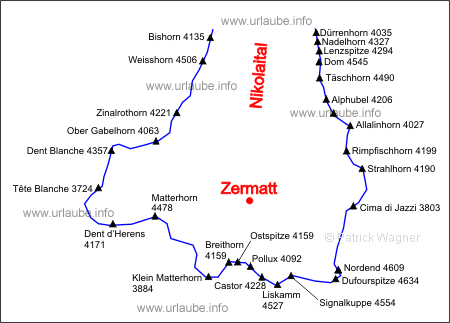
Of course, everybody links to Zermatt the most famous peak of the world, the 4478 m heighted Matterhorn. Majestically, the pyramid top enthrones isolated in a gorgeous world of mountains. It is the most pictured mountain of the world; in all parts of the earth it is known where this famous peak is located and its name. But what would be this famous peak without the other peaks surrounding it? In total, 29 four-thousander peaks rank around the Matterhorn; for comparison only: there are only 38 mountains in Switzerland which height begins with the number four. Thus, in Zermatt, there is not only the famous Matterhorn to gaze at, but a unique world of mountains, where the peaks top each other in height and mightiness.
But it is not only the Matterhorn and the other four-thousanders that make millions of tourists to come to Zermatt; it is also a fascinating symbiosis of the nature that consists on the high mountains, mighty, white gleamy Glaciers with their moraines, fabulous mountain lakes, in which, when there is no wind, the peaks use to reflect, colourful forests, that go up further than many other places of the Alps and, of course, the juicy meadows with colourful flowers and an abundant vegetation. From certain view points, all these elements can be enjoyed and gazed at simultaneously; this refreshes the mind and the heart!
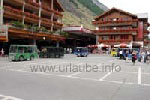
Apropos view points: what would be the beautiful world of mountains with its lakes, forests, meadows and brooks, if they couldn't be admired from all sides? Of course, those who explore the nature with hiking shoes and rucksack have the most benefit of it. For those who are more comfortable, Zermatt offers mountain rails and gondolas that bring one fast and for a lot of money up to the famous view points as the Klein Matterhorn, the Gornergrat or the Rothorn. The views that can be enjoyed there at a clear day cannot be described with words.
of course, the little city Zermatt offers many curiosities and uniqueness. Zermatt is a city without cars, thus in principle a huge pedestrian area. Not even the inhabitants are allowed to get through the city by car. Only some electric vehicles of the hotels, shops or handymen are allowed to drive through the narrow little streets. Thus, in Zermatt, within the whole city, the pedestrian is the king of the roads; this makes the place alive, either at daytime as also at night.
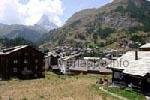
Most of the visitors of Zermatt are brief tourists that quickly picture the Matterhorn and have a walk through the city. But Zermatt is also a place where hikers find the initial point for countless and fascinating mountain tours. In Zermatt, the climbers also start their climb at the Matterorn or other four-thousanders. And of course, Zermatt also offers a huge ski areain the winter time, with countless lifts. White glacier pistes for beginners and steeply descends for experts. And those who also need between spring and autumn some boards under their feet from time to time, can also do their sweeps during the hottest summer at a height of 3500 m.
Hiking in Zermatt: On the steps of the Walser
Those who are on a hiking tour in the mountains of Zermatt come repeatedely across to little hamlets with the typical old wood houses, hay barns and little chapels. The role of it gets best clear by looking hals a millenium back to the history. Zermatt, only populated during the summer time due to the green mountain pastures, was not really populated until the 13th century. It was the time when the population of the Walser left their primordial home and populated the mountain valleys.
The Walser did not leave their home just for hiking, but because their living space was too short for the growing population. Thus, they slowly habitated calleys and regions of high mountains. It is to consider that at that times, it was easier to cross the passes, as there were different climatic circumstances as today. The Walser were mainly ranchers, herdsmen and hunters; they only worked in the agriculture in order to feed themselves.
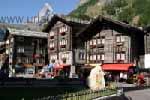
At adequate places, the Walser arranged some little hamlets as Winkelmatten, Blatten or Zmutt. The condition for establishing a place was always that there was enough water, extended meadows and forests and that the place was sunny and safe of avalanches. Still today, one can find in the little hamlets the typical little wooden houses and the hay barns standing on pillars. In the middle of the place, a chapel was always built; the higher at the top of a mountain a community lived, the more religious it was. Still today there are 12 chapels in the area of Zermatt that can be visited; the most famous one is at a height of 2500 m at the bottom of the Matterhorn right at the Schwarzsee.
The walser migration was, by the way, the biggest migration in the Alps ever. Also the German/Austrian Walser valley has its origin in the Walser population. Contrary to the former migration, the dispersion of the Walser took place in peace and without any complication; this is very notable in the human's history.
How Zermatt became a touristic metropolitis area
During the beginning of the 19th century, Zermatt was still an inconsiderable little place, but then, in the course of the time, Zermatt developed - it is hard to believe - thanks to the English people, to a touristic world metropolis of first degree. Actually, it was caused by the English people, who developed at the beginning of the 19th century a huge enthusiasm form mountain climbing. In the Zermatt area, they climbed up one four-thousander after the next. But it was not before the year 1865, when Edward Whymper climbed up the Matterhorn.
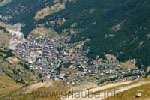
The big success of Whymper triggered in the English people a flood of travelling to Zermatt. The great Swiss hotelier Alexander Seiler was the fastest in recognizing the signs of the time and built in Zermatt (and in general, in whole Switzerland) an hotel imperium that still exists today (Seiler-Hotels). He did not only care on the accommodation of his English guests but made a big effort for the development of Zermatt.
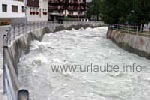
In the year 1891, the first train drove through the Nikolaital up to the new station of Zermatt. Therewith, Zermatt was fully connected to the Rhonetal and to the rest of the world and the development to be a huge touristic metropolis could ran its course. Today, there are more than 50 trains per day (commuter trains, Glacier Express, others) driving up to Zermatt that take thousands of tourists every day to the car free little city.
In the course of the last few decades, Zermatt has surely not only strongly changed in its number of inhabitants but also concerning the bustle on the narrow little streets. But nevertheless, Zermatt achieved to keep its fabulous being. In Zermatt, one lives nearly isolated from the world, practically "alone" in a little mountain city; there are no noisy cars and smelly vans, only a few electric cars that drive in snail pace through the little alleyways of the city.

Back to the index Zermatt
Copyright: Patrick Wagner, www.tourist-guide.biz
|
 |